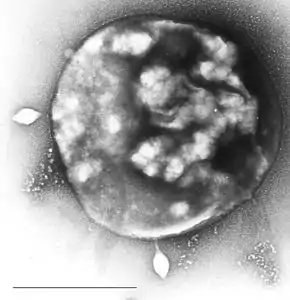TACK
Les TACK[1] (acronyme de Thaumarchaeota, Aigarchaeota, Crenarchaeota et Korarchaeota) ou Filarchaeota[2] forment un clade constituant un super-embranchement d'archées[1].

| Règne | Archaea |
|---|
L. Guy & T. Ettema (2011)
Filarchaeota Cavalier-Smith (2014)
Taxons de rang inférieur
- Phylum : Crenarchaeota
- Phylum : Aigarchaeota
- Phylum : Bathyarchaeota
- Phylum : Crenarchaeota
- Phylum : Geoarchaeota
- Phylum : Korarchaeota
- Phylum : Thaumarchaeota
- Phylum : Verstraetearchaeota
Ils vivent dans différents milieux favorisant des microorganismes allant de thermophiles acidophiles à mésophiles et même psychrophiles, avec différents métabolismes, principalement anaérobie et chimiosynthétique.
Les TACK constituent le groupe frère des Eukaryomorpha.
Cladogramme
D'après Tom A. Williams et al., 2017[3] et Castelle & Banfield, 2018[4] (DPANN) :
| Neomura |
| ||||||||||||||||||||||||||||||||||||||||||||||||||||||||||||||||||||||||||||||||||||||||||||||||||||||||||||||||||||||||||||||||||||||||||||||||||||||||||||||||||||||||||||||||||||||||||||||||||||||||||||||||||
Notes et références
- Guy L, Ettema TJ, « The archaeal 'TACK' superphylum and the origin of eukaryotes », Trends in Microbiology, vol. 19, no 12, , p. 580–87 (PMID 22018741, DOI 10.1016/j.tim.2011.09.002)
- Thomas Cavalier-Smith 2014, The Neomuran Revolution and Phagotrophic Origin of Eukaryotes and Cilia in the Light of Intracellular Coevolution and a Revised Tree of Life. Cold Spring Harbor Laboratory Press. DOI:10.1101/cshperspect.a016006
- (en) Tom A. Williams et al., Integrative modeling of gene and genome evolution roots the archaeal tree of life, publié en 2017 DOI:10.1073/pnas.1618463114
- (en) Castelle, C.J., Banfield, J.F., « Major New Microbial Groups Expand Diversity and Alter our Understanding of the Tree of Life », Cell, vol. 172, no 6, , p. 1181-1197 (PMID 29522741, DOI 10.1016/j.cell.2018.02.016)
- (en) Kiley W. Seitz, Nina Dombrowski, Laura Eme, Anja Spang, Jonathan Lombard et al., « Asgard archaea capable of anaerobic hydrocarbon cycling », Nature Communications, vol. 10, , article no 1822 (DOI 10.1038/s41467-019-09364-x).